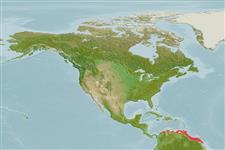>
Eupercaria/misc (Various families in series Eupercaria) >
Haemulidae (Grunts) > Haemulinae
Etymology: Haemulon: Greek, haimaleos = bloody (Ref. 45335).
Environment: milieu / climate zone / depth range / distribution range
Écologie
marin récifal; profondeur 0 - 100 m (Ref. 3798). Tropical; 22°N - 4°N, 98°W - 50°W
Western Atlantic: Colombia to French Guiana.
Taille / Poids / Âge
Maturity: Lm ? range ? - ? cm
Max length : 19.0 cm TL mâle / non sexé; (Ref. 9626); common length : 15.0 cm TL mâle / non sexé; (Ref. 3798)
Épines dorsales (Total): 13 - 14; Rayons mous dorsaux (Total): 13; Épines anales 3; Rayons mous anaux: 8 - 9. Head scaled except for tip of snout and chin; mouth small and oblique; yellowish to greenish silver on back, silvery on sides, with 4 brown to bronze stripes on upper half of body and a large black spot at caudal base (Ref. 13442).
Generally in protected areas such as bays or inlets; rarely in insular areas with clear oceanic water and coral reefs (Ref. 5217). Juveniles encountered near the shore. Feeds on small crustaceans and mollusks (Ref. 3798). Taken incidentally and not considered commercially important (Ref. 3798).
Life cycle and mating behavior
Maturité | Reproduction | Frai | Œufs | Fécondité | Larves
Distinct pairing during breeding (Ref. 205).
Cervigón, F., 1993. Los peces marinos de Venezuela. Volume 2. Fundación Científica Los Roques, Caracas,Venezuela. 497 p. (Ref. 9626)
Statut dans la liste rouge de l'IUCN (Ref. 130435)
Menace pour l'homme
Harmless
Utilisations par l'homme
Appât: occasionally
Plus d'informations
RéférencesAquacultureProfil d'aquacultureSouchesGénétiqueElectrophoresesHéritabilitéPathologiesTraitementNutrientsMass conversion
CollaborateursImagesStamps, Coins Misc.SonsCiguateraVitesseType de nageSurface branchialeOtolithesCerveauxVision
Outils
Articles particuliers
Télécharger en XML
Sources Internet
Estimates based on models
Preferred temperature (Ref.
123201): 25.4 - 28.2, mean 27.2 °C (based on 138 cells).
Phylogenetic diversity index (Ref.
82804): PD
50 = 0.5000 [Uniqueness, from 0.5 = low to 2.0 = high].
Bayesian length-weight: a=0.01479 (0.00702 - 0.03115), b=2.99 (2.82 - 3.16), in cm total length, based on LWR estimates for this Genus-body shape (Ref.
93245).
Niveau trophique (Ref.
69278): 3.5 ±0.50 se; based on food items.
Résilience (Ref.
120179): Haut, temps minimum de doublement de population inférieur à 15 mois (Preliminary K or Fecundity.).
Fishing Vulnerability (Ref.
59153): Low vulnerability (10 of 100).
Nutrients (Ref.
124155): Calcium = 65.2 [21.1, 122.1] mg/100g; Iron = 0.686 [0.359, 1.217] mg/100g; Protein = 19.1 [17.3, 20.9] %; Omega3 = 0.167 [0.087, 0.269] g/100g; Selenium = 31.9 [19.1, 54.3] μg/100g; VitaminA = 107 [43, 261] μg/100g; Zinc = 1.39 [0.95, 2.08] mg/100g (wet weight);
